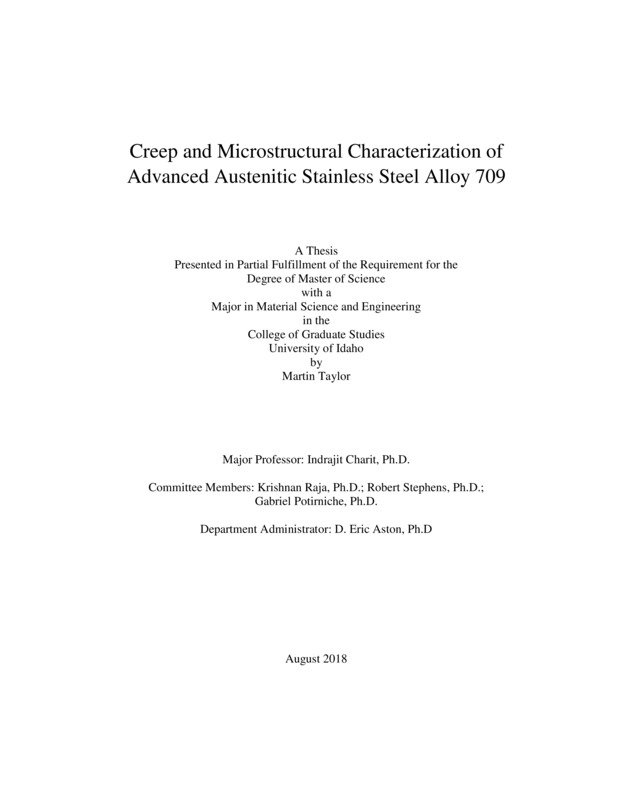Creep and Microstructural Characterization of Advanced Austenitic Stainless Steel Alloy 709
Taylor, Martin Russell. (2018-06). Creep and Microstructural Characterization of Advanced Austenitic Stainless Steel Alloy 709. Theses and Dissertations Collection, University of Idaho Library Digital Collections. https://www.lib.uidaho.edu/digital/etd/items/taylor_idaho_0089n_11407.html
- Title:
- Creep and Microstructural Characterization of Advanced Austenitic Stainless Steel Alloy 709
- Author:
- Taylor, Martin Russell
- Date:
- 2018-06
- Embargo Remove Date:
- 2020-07-08
- Keywords:
- Alloy 709 Austenitic Stainless Steel Creep fracture analysis Microstructure Nuclear materials
- Program:
- Chemical and Materials Science Engineering
- Subject Category:
- Materials Science
- Abstract:
-
Alloy 709 is a potential material for structural applications in advanced nuclear reactors such as sodium cooled fast reactors. It is a promising austenitic stainless steel that exhibits excellent high temperature creep strength, fatigue crack growth resistance, and corrosion resistance. However, fundamental information on the creep and fatigue behavior of the alloy is sparse. In this study, creep tests on Alloy 709 were performed at 600°C and 700°C under applied stresses of 125 to 250 MPa. The alloy exhibited a brief primary, insignificant secondary and prolonged tertiary creep stages. The stress exponent (n) of 6.7 and 5.9 was obtained from the Norton plots at 600°C and 700°C, respectively. Transgranular fracture was observed in creep-ruptured specimens. The Norton constants calculated in this study were utilized in a parallel collaborative effort involving finite element analysis models to predict creep-fatigue crack growth behavior of Alloy 709.
Thermal aging of Alloy 709 was carried out at 650°C for 3 and 6 months to study the effects of the detrimental sigma phase and M23C6 precipitates on the creep and tensile strength of the alloy. The overall creep behavior was described by the Bird-Mukherjee-Dorn relation. Dislocation climb was found to be the primary mechanism of creep deformation in Alloy 709. Microstructural analyses were carried out for the as-received and crept specimens using optical microscopy, scanning electron microscopy (SEM), electron backscattered diffraction (EBSD), and transmission electron microscopy (TEM). Some microstructural results (optical and EBSD) of the creep-fatigue crack growth and fatigue crack growth are also discussed.
- Description:
- masters, M.S., Chemical and Materials Science Engineering -- University of Idaho - College of Graduate Studies, 2018-06
- Major Professor:
- Charit, Indrajit
- Committee:
- Raja, Krishnan; Potirniche, Gabriel; Stephens, Robert R
- Defense Date:
- 2018-06
- Identifier:
- Taylor_idaho_0089N_11407
- Type:
- Text
- Format Original:
- Format:
- application/pdf
- Rights:
- In Copyright - Educational Use Permitted. For more information, please contact University of Idaho Library Special Collections and Archives Department at libspec@uidaho.edu.
- Standardized Rights:
- http://rightsstatements.org/vocab/InC-EDU/1.0/

